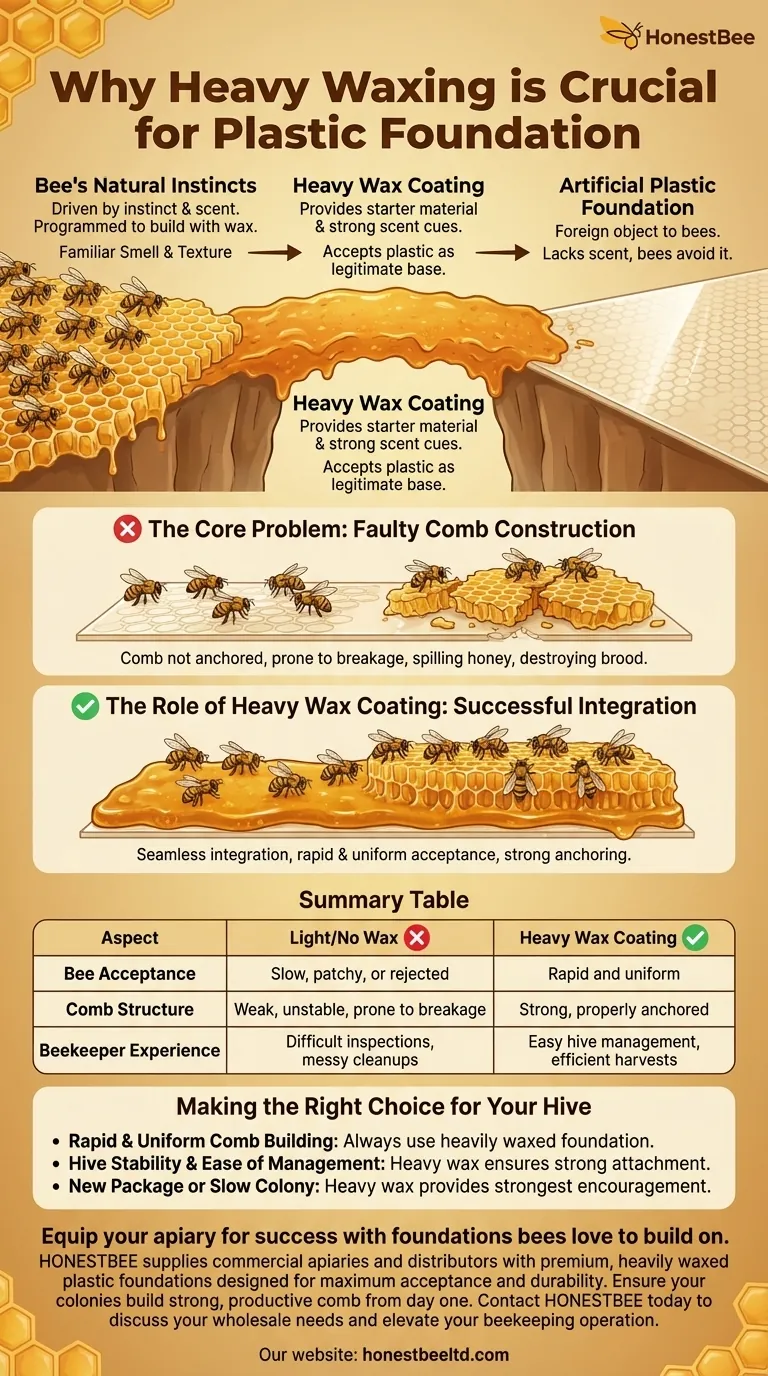At its core, heavy waxing is crucial because it bridges the gap between a bee's natural instincts and the artificial nature of plastic foundation. Bees are biologically programmed to build with and on beeswax; a thick, high-quality wax coating provides the necessary scent and material cues to convince the colony to accept the plastic sheet as a legitimate base for building their comb.
Bees do not build on plastic, they build on wax. A heavy wax coating on a plastic foundation isn't just a suggestion—it's the essential instruction manual that tells the bees how to build a strong, uniform, and productive hive.

The Core Problem: A Bee's Natural Instinct
To understand the need for wax, you must first understand the bee. Their entire world is built upon the wax they secrete and meticulously shape.
Why Bees Reject Bare Plastic
Bees are driven by instinct and scent. A bare piece of plastic is a completely foreign object in the hive environment. It lacks the familiar smell and texture of beeswax.
Faced with un-waxed or poorly waxed plastic, bees will treat it as an obstacle. They will not build directly upon it.
The Consequence: Faulty Comb Construction
When bees avoid the foundation, they build comb with minimal contact points, often leaving a small gap between the plastic and the start of their cells.
This creates a structurally weak and unstable honeycomb. The comb is not properly anchored to the foundation, making it prone to breaking off during hive inspections or honey extraction. This can destroy brood, spill honey, and create a massive cleanup job for the bees and the beekeeper.
The Role of a Heavy Wax Coating
A proper wax coating transforms the plastic foundation from a foreign object into an acceptable building site. The quality and thickness of this coating are what determine success or failure.
Providing the "Starter" Material
A heavy layer of beeswax gives the bees a resource to work with immediately. They can manipulate and add to this existing wax, seamlessly integrating the foundation into their construction.
The strong scent of real beeswax also acts as a powerful attractant and signal, stimulating their natural comb-building behavior.
Light Wax vs. Heavy Wax
Many commercially available foundations come with a very thin, almost invisible layer of wax. This is often insufficient.
Bees may draw out comb on lightly waxed foundation, but it is often slow, patchy, and inconsistent. A heavy wax coating, which you can see as a thick, textured layer and easily smell, ensures rapid and uniform acceptance across the entire frame.
Common Pitfalls and How to Avoid Them
Simply using plastic foundation is not enough; you must ensure it meets the bees' requirements.
Identifying Poorly Waxed Foundation
A properly waxed foundation will have a strong, pleasant beeswax aroma. You should be able to see a visible, often slightly uneven, layer of wax on the surface.
If the plastic looks shiny and has little to no scent, it needs more wax. You can scrape a small area with your thumbnail; a good coating will produce a small curl of wax.
Applying Additional Wax
If you have under-waxed foundation, you can correct it yourself. The most common method is to use a paint roller or foam brush to apply melted, clean beeswax.
The goal is to apply a consistent, thick coat that fills the contours of the cell imprints, providing a rich surface for the bees to begin their work.
Making the Right Choice for Your Hive
Your goal as a beekeeper is to support your bees' natural tendencies to create a productive and healthy hive. Your choice of foundation is a critical part of that.
- If your primary focus is rapid and uniform comb building: Always use heavily waxed plastic foundation to guarantee quick acceptance and efficient work by the bees.
- If your primary focus is hive stability and ease of management: A heavy wax coat ensures the comb is strongly attached, preventing breakage during inspections and honey harvesting.
- If you are working with a new package or a slow-building colony: A heavily waxed foundation is non-negotiable, as it provides the strongest possible encouragement for a colony to start building.
Ultimately, successful beekeeping means working with the nature of the bee, and providing a heavily waxed foundation is a perfect example of this principle in action.
Summary Table:
| Aspect | Light/No Wax | Heavy Wax Coating |
|---|---|---|
| Bee Acceptance | Slow, patchy, or rejected | Rapid and uniform |
| Comb Structure | Weak, unstable, prone to breakage | Strong, properly anchored |
| Beekeeper Experience | Difficult inspections, messy cleanups | Easy hive management, efficient harvests |
Equip your apiary for success with foundations bees love to build on. HONESTBEE supplies commercial apiaries and beekeeping equipment distributors with premium, heavily waxed plastic foundations designed for maximum acceptance and durability. Ensure your colonies build strong, productive comb from day one. Contact HONESTBEE today to discuss your wholesale needs and elevate your beekeeping operation.
Visual Guide

Related Products
- Food Grade Plastic bee Foundation for Bee Frames
- Notebook Style Beeswax Foundation Mould Wax Foundation Mold
- Professional Frame Preparation: The HONESTBEE Electric Wire Embedder
- HONESTBEE Pneumatic Dual Wire Embedder for W-Pattern Foundation Wiring
- Electric Flatting and Embossing Machine with Tray for Beekeeping
People Also Ask
- What is a plastic foundation sheet? A Durable, Reusable Hive Management Solution
- What factors should beekeepers consider when choosing between beeswax and plastic foundation? A Guide to Durability vs. Natural Philosophy
- How to get bees to use plastic foundation? Master the Wax Coating and Resource Strategy
- Why is it beneficial to coat plastic foundation with beeswax? Boost Hive Acceptance & Comb Building
- What additional step can improve the performance of plastic foundation in the hive? Apply a Generous Coat of Beeswax


















